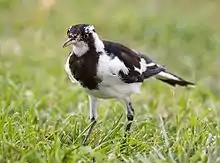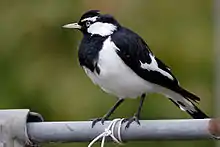Magpie-lark
The magpie-lark (Grallina cyanoleuca), also known as the peewee, peewit or mudlark, is a passerine bird native to Australia, Timor and southern New Guinea. The male and female both have black and white plumage, though with different patterns. John Latham described the species in 1801. Long thought to be a member of the mudnest builder family Corcoracidae, it has been reclassified in the family Monarchidae (the monarch flycatchers). Two subspecies are recognized.
| Magpie-lark | |
|---|---|
 | |
| Female | |
 | |
| Male | |
| Scientific classification | |
| Kingdom: | Animalia |
| Phylum: | Chordata |
| Class: | Aves |
| Order: | Passeriformes |
| Family: | Monarchidae |
| Genus: | Grallina |
| Species: | G. cyanoleuca |
| Binomial name | |
| Grallina cyanoleuca (Latham, 1801) | |
 | |
| Distribution shown in green | |
| Synonyms | |
| |
Taxonomy and systematics
The magpie-lark was originally described by the English ornithologist John Latham in the genus Corvus in 1801 (as Corvus cyanoleucus).[2][3] Its species name is derived from the Ancient Greek words cyanos "dark blue" and leukos "white" despite the black and white plumage. However, there can be a bluish sheen to the black back.[4] In the same publication, Latham described the same species as Gracula picata.[2][5] In 1843, Hugh Edwin Strickland proposed using the second name as it was the more accurate, resulting in Grallina picata.[6] Formerly, some authorities have classified the magpie-lark as belonging to a genus of bee-eaters, Merops.
Latham gave the species the common names of blue and white crow and pied grackle, based on the scientific names.[3][5] John Gould likewise called it the pied grallina in 1848, though he noted that it was called magpie-lark by the early settlers.[7] Alternate names for the magpie-lark include the mudlark (more common in southeastern Australia[8]) or pugwall (pug "clay"), from its nest, and peewee (more common in northeastern Australia[8]), peewit, from its call.[4] Unlike many species in southwestern Australia, the magpie-lark was given names by the local indigenous people that were onomatopoeic (sounding like the calls they make). Names recorded include byoolkolyedi (Perth and lowlands), dilabot (mountains and interior), and koolyibarak.[9] Indigenous people in the Sydney region called it birrarik or birrerik.[10]
Additional common names used regionally include Murray magpie in South Australia.[4]

In 1977, the RAOU settled on Australian magpie-lark as the official name, noting that the names magpie lark and, less commonly, mudlark were used in guidebooks at the time.[11]
Two subspecies are recognised:[12]
- G. c. cyanoleuca – (Latham, 1801): Found in western, central, eastern and southern Australia
- G. c. neglecta – Mathews, 1912: Found in northern Australia
Long thought to be a member of the mudnest builder family Corcoracidae, the magpie-lark and the closely related torrent lark (Grallina brujini) have been reclassified in the family Monarchidae (the monarch flycatchers). The two make up a lineage that split off early from other monarchs and has no close relatives within the family.[13]
Description

The magpie-lark is of small to medium size, reaching 25 to 30 cm (9.8 to 11.8 in) long when fully grown, or about the same size as a European common blackbird, and boldly pied in black and white; the weight range is 63.9 to 118 g (2.25 to 4.16 oz) for males, and 70 to 94.5 g (2.47 to 3.33 oz) for females.[14] The sexes are similar from a distance but easy to tell apart: the female has a white throat, the male a black throat and a white "eyebrow". Juveniles and immatures of either sex have the white throat of the female and the black eyestripe of the male, and a white belly.[14]
Distribution and habitat
The magpie-lark is a common and very widespread bird both in urban and rural areas, occupying all parts of Australia except for Tasmania and some of the inland desert in the far north-west of Western Australia, and appears to have adapted well to the presence of humans. It is also found in southern New Guinea and on the island of Timor. In 1924 it was introduced onto Lord Howe Island which lies 600 km (370 mi) to the east of Australia in the Tasman Sea. It is now widespread on the island.[14] The magpie-lark is a familiar sight around Australia; sitting on telephone wires either singly or in pairs, or patrolling patches of bare ground, especially foreshores or swamps.
Behaviour and ecology

A primarily carnivorous species that eats all sorts of small creatures, the magpie-lark can adapt to an enormous range of different habitats, requiring only some soft, bare ground for foraging, a supply of mud for making a nest, and a tree to make it in. It has benefited greatly from agriculture: both the clearing of dense forest in fertile zones and the provision of artesian water in arid areas—although a disaster for other species—have been a boon for bare-ground and short-grass feeders like magpies and magpie-larks.
Group gatherings of magpie-larks have been observed, with loose "flocks" comprising dozens of individuals being observed perched on vantage points. Such behaviour is common, particularly in productive agricultural areas. This behaviour may be pairing or breeding related or simply indicate a bountiful feeding area.
The magpie-lark is aggressively territorial, and will fearlessly defend its territory against larger species such as magpies, ravens, kookaburras, and even the wedge-tailed eagle. They are also known to attack people to defend their nesting area.[lower-alpha 1][19] Although attacks on people are not as aggressive as masked lapwings and magpies, they can still result in surprise or minor injury to the recipient.
They are also known to attack mirrors, windows and other reflective surfaces in which they mistake their reflection for an intruder into their territory.[20]
Breeding

Birds generally pair for life (though divorce is not unknown) and defend a territory together. The nest is round, about 150 mm in diameter with vertical sides and is usually placed on a flat branch somewhere near water or on a horizontal beam of a telephone pole. It is made of grass and plant material thickly plastered together with mud, and generously lined with grass, feathers and fur. Breeding is opportunistic, usually from August to February in the fertile south, anytime after rain in drier areas, and multiple broods are common when conditions allow. Both parents incubate a clutch of between three and five eggs. Incubation of eggs takes up to eighteen days, and the young birds fledge about three weeks after hatching. It is quite common for only some of the chicks to survive because sometimes the nest is not big enough for all of the baby birds, therefore one baby will sometimes push another out of the nest and it is most likely that the chick will not survive the fall.
Duet singing
Magpie-larks are one of the 200-odd species of bird around the world that are known to sing in duet; each partner producing about one note a second, but a half-second apart, so that humans find it difficult to tell that there are actually two birds singing, not one.
Traditionally, it has been thought that the function of duet singing (not just in magpie-larks but birds more generally and indeed in mammals, insects and frogs) was to defend a territory or to maintain the pair-bond. More recently it has been proposed that it serves to guard against infidelity—that the male sings to attract a mate, and the female joins in to let her rivals know that this particular male is already taken. Duet singing remains fairly poorly understood as a great deal of the existing research on birdsong has been carried out in the northern Hemisphere, where a fairly small number of female birds sing.
In the case of the magpie-lark, the duet singing is now known to be cooperative: pairs sing together to defend their territory. Magpie-larks sing more vigorously in response to duet calls from other birds than they do to the call of a single rival, and more vigorously still if the callers are strangers rather than established and familiar birds from a neighbouring territory. A pair of neighbours calling from the 'wrong' place, however, (as when calls are recorded and played back by an experimenter) bring forth a powerful reaction: clearly, they know exactly who their neighbours are.[21]
 A male magpie-lark showing dorsal feather colouring.
A male magpie-lark showing dorsal feather colouring.

 A magpie-lark attacking a car mirror.
A magpie-lark attacking a car mirror.
References
- BirdLife International (2016). "Grallina cyanoleuca". IUCN Red List of Threatened Species. 2016: e.T22707425A94123194. doi:10.2305/IUCN.UK.2016-3.RLTS.T22707425A94123194.en.
- Mayr, E. (1962). "Family Granillidae, Australian mud nest builders". In Mayr, E.; Greenway, J.C. Jr. (eds.). Check-list of birds of the world, Volume XV. Cambridge, Massachusetts: Museum of Comparative Zoology. p. 159.
- Latham, John (1801). Supplementum indicis ornithologici sive systematis ornithologiae (in Latin). London: G. Leigh and S. Sotheby. p. 25.
- Gray, Jeannie; Fraser, Ian (2013). Australian Bird Names: A Complete Guide. Collingwood, Victoria: Csiro Publishing. p. 249. ISBN 978-0-643-10471-6.
- Latham, John (1801). Supplementum indicis ornithologici sive systematis ornithologiae (in Latin). London: G. Leigh and S. Sotheby. p. 29.
- Strickland, Hugh Edwin (1843). "Remarks on a collection of Australian drawings of birds, the property of the Earl of Derby". Annals and Magazine of Natural History. 11: 333–38. doi:10.1080/03745484309445312.
- Gould, John (1848). The birds of Australia. Volume 2. London: Self-published. Plate 54.
- Bryant, Pauline (2011). Regional variation in the lexicon of Australian English (Thesis).
- Abbott, Ian (2009). "Aboriginal names of bird species in south-west Western Australia, with suggestions for their adoption into common usage" (PDF). Conservation Science Western Australia Journal. 7 (2): 213–78 [265–66].
- Troy, Jakelin (1993). The Sydney Language (PDF). Canberra: Self-published. ISBN 0-646-11015-2.
- Emison, W.B.; Bren, W.M. (1977). "Recommended English Names for Australian Birds". Emu. 77 (5): 245–313. doi:10.1071/MU9770245s.
- Gill, Frank; Donsker, David (eds.). "Monarchs". World Bird List Version 7.1. International Ornithologists' Union. Retrieved 31 January 2017.
- Andersen, M.J.; Hosner, P.A.; Filardi, C.E.; Moyle, R.G. (2015). "Phylogeny of the monarch flycatchers reveals extensive paraphyly and novel relationships within a major Australo-Pacific radiation". Molecular Phylogenetics and Evolution. 83: 118–36. doi:10.1016/j.ympev.2014.11.010. PMID 25463752.
- Tingay, A.; Tingay, S. (2009). "Magpie-lark (Grallina cyanoleuca)". In del Hoyo, J.; Elliott, A.; Sargatal, J.; Christie, D.A.; de Juana, E. (eds.). Handbook of the Birds of the World Alive. Lynx Edicions. Retrieved 9 December 2015.(subscription required)
- http://www.trevorsbirding.com/larking-around/
- Joyce, Nikkii (8 June 2010). "Grumpy peewee attacks little girl". Sunshine Coast Daily. APN. Retrieved 30 August 2015.
- Mannix, Liam (8 July 2014). "Swooping bird attacks woman at Richmond train station". The Age. Fairfax Media. Retrieved 30 August 2015.
- Billias, Maria (5 June 2015). "Swooping bird attacks glamour girls in Mitchell St frenzy". NT News. News Corp. Retrieved 30 August 2015.
- http://www.dpi.wa.gov.au/mediaFiles/cycling_factsheets_birds.pdf archived at https://web.archive.org/web/20110330064540/https://www.dpi.wa.gov.au/mediaFiles/cycling_factsheets_birds.pdf
- "Archived copy". Archived from the original on 2017-04-16. Retrieved 2017-04-15.CS1 maint: archived copy as title (link)
- "No larking matter: a duet's dire precision", Richard Macey, June 5, 2007, The Sydney Morning Herald
Further reading
- Hall, M.L.; Magrath, R.D. (2007). "Temporal coordination signals coalition quality". Current Biology. 17 (11): R406–R407. doi:10.1016/j.cub.2007.04.022. PMID 17550763.
External links
| Wikimedia Commons has media related to Magpie-lark. |
| Wikispecies has information related to Grallina cyanoleuca. |
- Magpie-lark videos, photos & sounds on the Internet Bird Collection
